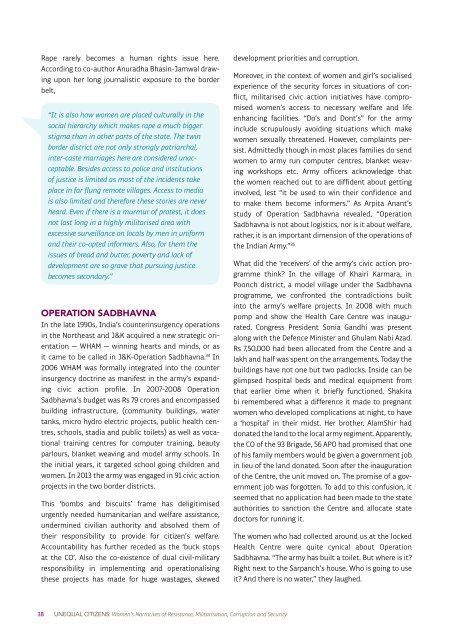CC_India
CC_India
CC_India
You also want an ePaper? Increase the reach of your titles
YUMPU automatically turns print PDFs into web optimized ePapers that Google loves.
Rape rarely becomes a human rights issue here.<br />
According to co-author Anuradha Bhasin-Jamwal drawing<br />
upon her long journalistic exposure to the border<br />
belt,<br />
“It is also how women are placed culturally in the<br />
social hierarchy which makes rape a much bigger<br />
stigma than in other parts of the state. The twin<br />
border district are not only strongly patriarchal,<br />
inter-caste marriages here are considered unacceptable.<br />
Besides access to police and institutions<br />
of justice is limited as most of the incidents take<br />
place in far flung remote villages. Access to media<br />
is also limited and therefore these stories are never<br />
heard. Even if there is a murmur of protest, it does<br />
not last long in a highly militarised area with<br />
excessive surveillance on locals by men in uniform<br />
and their co-opted informers. Also, for them the<br />
issues of bread and butter, poverty and lack of<br />
development are so grave that pursuing justice<br />
becomes secondary.”<br />
OPERATION SADBHAVNA<br />
In the late 1990s, <strong>India</strong>’s counterinsurgency operations<br />
in the Northeast and J&K acquired a new strategic orientation<br />
— WHAM — winning hearts and minds, or as<br />
it came to be called in J&K–Operation Sadbhavna. 34 In<br />
2006 WHAM was formally integrated into the counter<br />
insurgency doctrine as manifest in the army’s expanding<br />
civic action profile. In 2007-2008 Operation<br />
Sadbhavna’s budget was Rs 79 crores and encompassed<br />
building infrastructure, (community buildings, water<br />
tanks, micro hydro electric projects, public health centres,<br />
schools, stadia and public toilets) as well as vocational<br />
training centres for computer training, beauty<br />
parlours, blanket weaving and model army schools. In<br />
the initial years, it targeted school going children and<br />
women. In 2013 the army was engaged in 91 civic action<br />
projects in the two border districts.<br />
This ‘bombs and biscuits’ frame has deligitimised<br />
urgently needed humanitarian and welfare assistance,<br />
undermined civilian authority and absolved them of<br />
their responsibility to provide for citizen’s welfare.<br />
Accountability has further receded as the ‘buck stops<br />
at the CO’. Also the co-existence of dual civil-military<br />
responsibility in implementing and operationalising<br />
these projects has made for huge wastages, skewed<br />
development priorities and corruption.<br />
Moreover, in the context of women and girl’s socialised<br />
experience of the security forces in situations of conflict,<br />
militarised civic action initiatives have compromised<br />
women’s access to necessary welfare and life<br />
enhancing facilities. “Do’s and Dont’s” for the army<br />
include scrupulously avoiding situations which make<br />
women sexually threatened. However, complaints persist.<br />
Admittedly though in most places families do send<br />
women to army run computer centres, blanket weaving<br />
workshops etc. Army officers acknowledge that<br />
the women reached out to are diffident about getting<br />
involved, lest “it be used to win their confidence and<br />
to make them become informers.” As Arpita Anant’s<br />
study of Operation Sadbhavna revealed, “Operation<br />
Sadbhavna is not about logistics, nor is it about welfare,<br />
rather, it is an important dimension of the operations of<br />
the <strong>India</strong>n Army.” 35<br />
What did the ‘receivers’ of the army’s civic action programme<br />
think? In the village of Khairi Karmara, in<br />
Poonch district, a model village under the Sadbhavna<br />
programme, we confronted the contradictions built<br />
into the army’s welfare projects. In 2008 with much<br />
pomp and show the Health Care Centre was inaugurated.<br />
Congress President Sonia Gandhi was present<br />
along with the Defence Minister and Ghulam Nabi Azad.<br />
Rs 7,50,000 had been allocated from the Centre and a<br />
lakh and half was spent on the arrangements. Today the<br />
buildings have not one but two padlocks. Inside can be<br />
glimpsed hospital beds and medical equipment from<br />
that earlier time when it briefly functioned. Shakira<br />
bi remembered what a difference it made to pregnant<br />
women who developed complications at night, to have<br />
a ‘hospital’ in their midst. Her brother, AlamShir had<br />
donated the land to the local army regiment. Apparently,<br />
the CO of the 93 Brigade, 56 APO had promised that one<br />
of his family members would be given a government job<br />
in lieu of the land donated. Soon after the inauguration<br />
of the Centre, the unit moved on. The promise of a government<br />
job was forgotten. To add to this confusion, it<br />
seemed that no application had been made to the state<br />
authorities to sanction the Centre and allocate state<br />
doctors for running it.<br />
The women who had collected around us at the locked<br />
Health Centre were quite cynical about Operation<br />
Sadbhavna. “The army has built a toilet. But where is it?<br />
Right next to the Sarpanch’s house. Who is going to use<br />
it? And there is no water,” they laughed.<br />
38 UNEQUAL CITIZENS: Women’s Narratives of Resistance, Militarisation, Corruption and Security


